The ASUS ZenPad S (Z580CA) Review
by Brandon Chester on August 31, 2015 8:00 AM ESTDisplay: Stock Settings
I often say that a smartphone is just a display you interact with, which makes the need for a high quality screen paramount. This is even more true for tablets, which are quite literally large touchscreen displays that the user interacts with. With tablet displays having peaked in terms of resolution for the time being, manufacturers are now turning their attention toward color accuracy. Flagship devices like Samsung's Galaxy Tab S tablets and Apple's full sized iPads feature displays with an exceptional level of color accuracy, while smaller or less expensive tablets are more hit-and-miss.
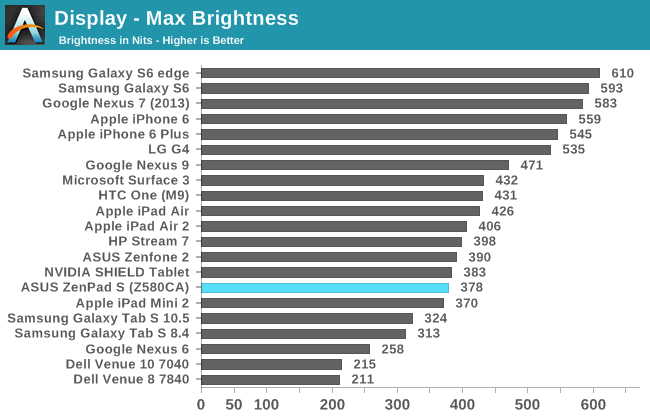

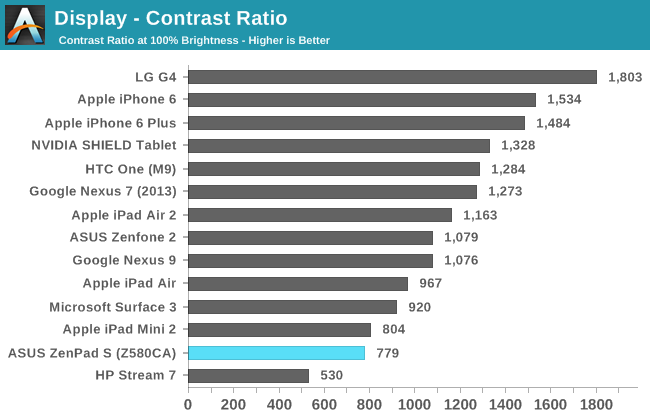
Unsurprisingly, the ZenPad's display is very similar to that of the iPad Mini 2 as far as brightness, black level, and contrast are concerned. While Apple has decided to round 7.85" to 7.9", and ASUS has decided to round to 8.0", I'm fairly confident both devices are using the same LCD technology with different backlight arrays. It should be noted that while the contrast ratio is similar in our measurements, when there is ambient light there will be a much more significant drop in contrast on the iPad Mini 2 due to its unlaminated display.
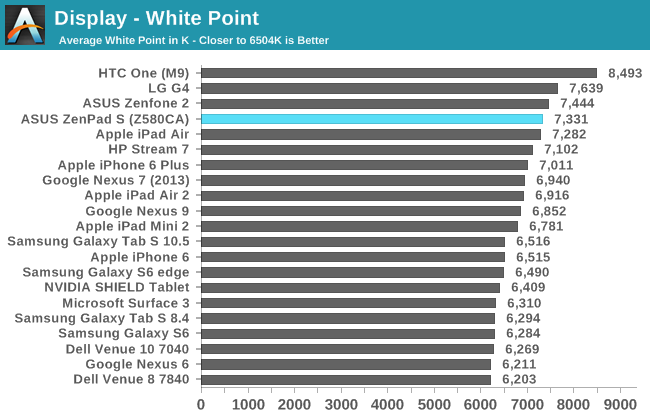
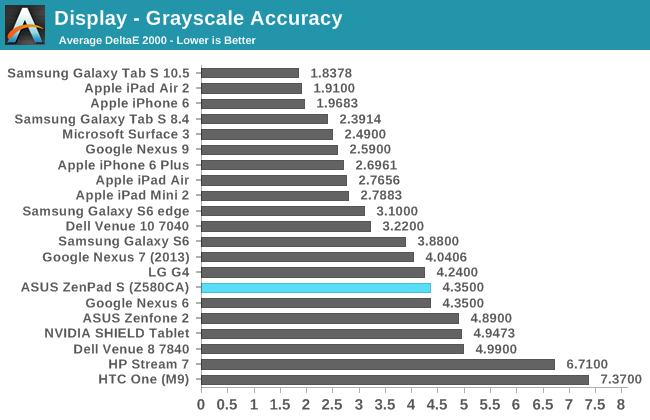
Even if two devices use the same display panel, the color characteristics of each can vary significantly depending on the level of calibration, as well as the spectral range of the LED backlight used. Apple’s iPad Mini 2 achieves a level of greyscale accuracy where errors can only be seen in static content, and is good enough for editing photos and videos without concerns about the accuracy of the images. The ZenPad S doesn’t do as well, with a significant blue shift to most shades of grey. This is also reflected in the display’s high average white point of 7331K. While the ZenPad S doesn’t cost as much as an iPad Air 2 or a Galaxy Tab S2, the Z580CA’s price of $299 is exactly the same as the iPad Mini 2. With that in mind, it’s concerning to see such a gap between the greyscale performance of the ZenPad S and the iPad Mini 2.
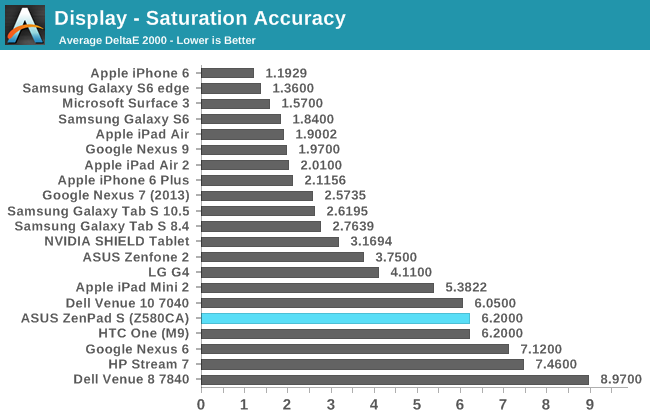
Saturation accuracy on the ZenPad S is much lower than what could be achieved with more attention paid to the display’s calibration. With a DeltaE average of 6.2, the ZenPad S is actually less accurate with rendering primary and secondary colors than the iPad Mini 2, despite the latter having a backlight array that only allows for narrow coverage of the blue and red parts of the sRGB gamut. The spectral range of the LEDs in the ZenPad S almost covers the entire sRGB gamut, but the panel undershoots significantly with reds, overshoots with blue beyond 60% saturation, and has various levels of inaccuracy with yellow, cyan, and most of all, magenta. I was really excited to see that the ZenPad S doesn’t suffer from the narrow gamut of the iPad Mini 2, but I was let down when I realized that the accuracy of primary and secondary colors was actually worse than the iPad due to inadequate calibration.
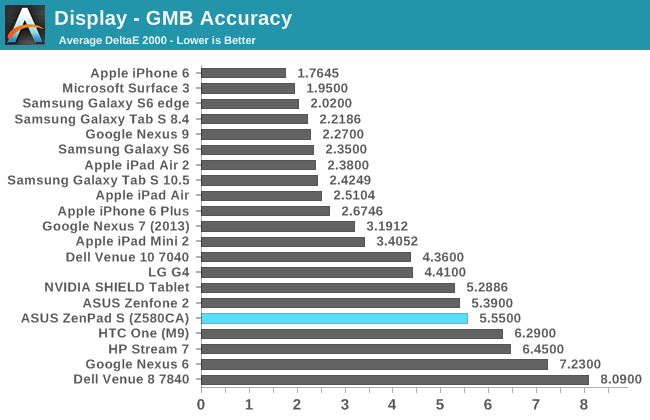
Accurately reproducing color mixtures requires a reasonably accurate gamma, RGB balance for grey shades, and accurate saturations. Gamma on the ZenPad S is reasonably accurate for a mobile device, but the way the display tends toward blue coupled with the inaccurate saturations results in inaccurate color mixtures as well. The ZenPad’s average DeltaE of 5.55 doesn’t compare favorably with the iPad Mini 2’s DeltaE of 3.4 which is imperfect but still fairly accurate. The reason that the iPad Mini 2 ends up being more accurate is because while it cannot be accurate outside its native gamut, within the section of sRGB that it does cover it is very accurate.
As far as the default display configuration of the ZenPad S goes, I’m not exactly thrilled. While it does have a wider gamut than the iPad Mini 3, it ends up being less accurate in every respect due to issues with rendering primary and secondary colors, and a blue shift in the greyscale. Surprisingly, the ZenPad S having a fully laminated display has done nothing to reduce black levels and increase contrast ratio when compared to the non-laminated iPad Mini 2 display, which is an additional disappointment. However, ASUS does provide a few settings to tweak the display, and so hope is not lost.


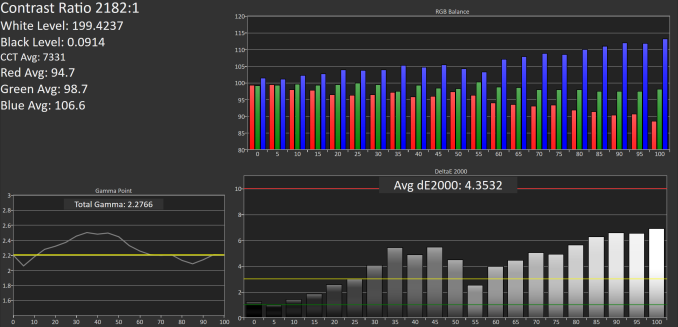

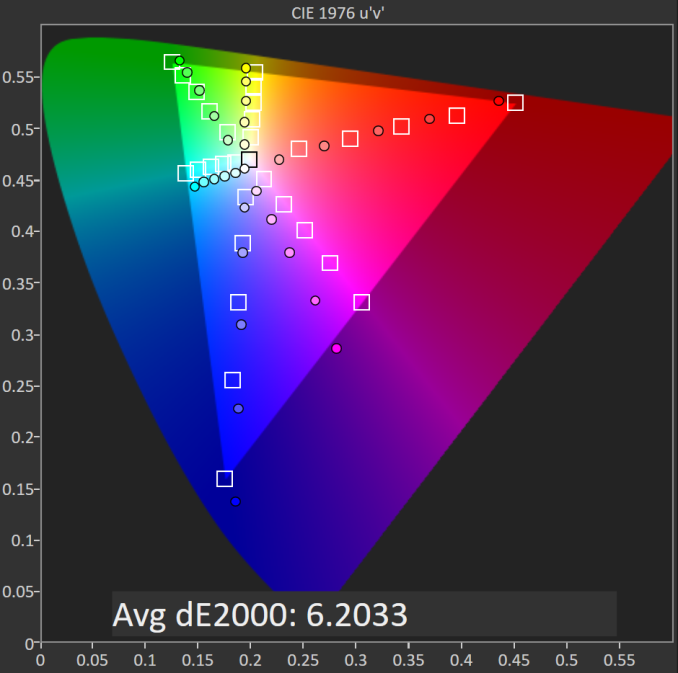









114 Comments
View All Comments
BugblatterIII - Monday, August 31, 2015 - link
I wasn't even talking about the GPS; way to jump to conclusions and run a mile with them!And I did get the dongle.
3DoubleD knows what he's talking about (oh and don't forget the interminable hangs on web browsing). MrSavage I suggest you read and learn.
My current router and motherboard are from Asus, no complaints. When it comes to tablets (and probably smartphones) I'd steer well clear. This review mentions some serious issues at launch; they shouldn't exist.
MrSavage - Monday, August 31, 2015 - link
If you recall, the Prime just came out, some hadn't even shipped, and Asus showed of the Transformer Infinity at CES to the dismay of many. The fact is this. That was a ground breaking product, in its second iteration. Nobody else was attempting what they did. Design wise a fail? Sure. But to me, I give full credit for a company that has the balls to release innovative and cutting edge products. They didn't repeat the mistake. Hold a grudge? LOL, go ahead. I'll always praise innovation even if it means problems. Apple antennagate? Happens to even the best companies out there.BugblatterIII - Tuesday, September 1, 2015 - link
The bits they failed on weren't the innovative bits. The keyboard worked very well for example. It was the actual tablet bit where they fell down. They shouldn't have shipped it in that state; they used seriously under-specced hardware and that's probably the real reason they were never able to fix it with firmware.A few years on perhaps they've learned, or perhaps the decision-makers have changed. However the fact they're launching with major issues suggests otherwise, and those who do not learn from history are doomed to take Summer School.
You call it holding a grudge; I call it learning from experience. Same reason I won't touch Belkin.
3DoubleD - Tuesday, September 1, 2015 - link
Agreed. The innovative bits were great. The keyboard with extra battery life - fantastic. Screen was beautiful, even if it was only 720p. Two SD card slots and a full sized USB port - great. ASUS' Android wasn't even too bad (pretty close to stock with some small, helpful additions). But screwing up one of the core components of the system was not a failed innovation, it was poor engineering and quality control. It was also a not a common failure that was unique to the Prime, despite all phones and tablets having eMMC devices. It was such a failure, crippling the usability to such an extent that a recall should have taken place. Hilariously, the previous Transformer tablet has aged far better, while having all of the innovative features, so again, I don't think ASUS should get a free pass because it was 'ballsy'.3DoubleD - Tuesday, September 1, 2015 - link
"It was also a not a common failure, *but* was unique to the Prime..."MrSavage - Monday, August 31, 2015 - link
I registered to ask this question. You guys are known for your "technical" analysis. The issue with reviews is with the basis of comparison or lack thereof. Instead of saying this is the best $299 8-inch Android tablet on the market, you can't and really don't. Instead, you suggest spending another 1/3 of the price for something else!? Or yet get an old, outdated iPad mini 2?What are front facing speakers worth to a tablet user? What is a stylus input worth to a tablet user?
It would seem that the reviewer doesn't know the Samsung Tab S2 8.0. Explain what that extra $100 in price gets you, that's better than the $100 cheaper Android tablet. The point is, expand on a spec basis what makes the extra $100 a better buying option. Perhaps your readers only shop for the most expensive product. In that case, each review will be price based. The most expensive on the market = the best. Thus, a review just explains why the premium cost is worthwhile. To write in the review that looking at the $100 more expensive Tab S2 is worth considering? How about why? Why is that worth it?
DanNeely - Monday, August 31, 2015 - link
*sigh* Up until I saw the display and battery sections I was somewhat interested in this tablet.Is there anyone selling an 8" android tablet that isn't either a cheap wretched piece of crap or fundamentally broken in some way (eg Samsung's backwards buttons, Kindle's lack of Google apps, etc)?
MrSavage - Monday, August 31, 2015 - link
Unrealistic consumer? Wants - long battery life, best display on market. Wants - cheapest price possible. Seriously? If battery life is crucial, there are things called external battery packs. $20 perhaps? Not tied into a device and can be used for other devices. Display issues? Check the specs on the new Tab S2 8.0 and then look at the price. I think I go back to the first two words I wrote in this comment. Something to think about.DanNeely - Monday, August 31, 2015 - link
How exactly do you go from my not wanting a cheap piece of crap to my wanting something as cheap as possible? For that matter I just cited Samsung's tablets as an example of a device with a fundamentally broken mis-feature.I want a good tablet without anything stupidly wrong on it. I'd gladly pay $400 for something like the Tab S2 8 if Samsung didn't insist on ruining all of their Android devices by screwing the buttons up.
As it is, the Android tablet market has gotten worse than the PC laptop market. The latter at least has enough options that, even though virtually every product has at least one item where they either cheaped out one component to something awful to save a dollar on the BOM or made an generally idiotic design option, I can at least find something that doesn't have a flaw that's a show stopper for me. (XPS 13 laptop, the black tape lens cap on the neckbeard/nose hair camera is less noticeable than the tape over a more conventionally placed camera.) I've been on/off looking for an android tablet all summer; but every time I see something to catch my eye midway through the review there's something that triggers an immediate "OH HELL NO!!!" response.
MrSavage - Monday, August 31, 2015 - link
You are simply being unrealistic, that's my point. Android isn't Apple. Go ahead and go spec by spec through the Z580CA and Tab S2 8.0 comparison and then add the extra $100 you would be spending on that new Samsung.If you think for a moment that the Z580CA is a cheap piece of crap, then no doubt why you are without an Android tablet. You are taking this review as the final word.
Battery life can be solved pretty darn easily, unless their is some issue with portable charger and Type-C.
I am curious though, what's the "hell no" aspect of the Z580CA? I hope it's not the wifi which has been reviewed on a firmware that needs updating/tweaking.
Display wise? I think the reviewer has a built in bias against display enhancements. Lots of charts and graphs talking about display. However, do you really think any of those graphs and charts mean anything to the real world, end user? If you are an elite user, then go ahead and look outside of Android and pay double or triple the price for an Apple display.
I hear what you want. You want an Apple quality device with Android OS. I think the manufacturers have tried and failed at that game and it's why price is their primary goal. Perhaps you can hope for a ZenPad Pro or something similar.
Personally? I would rather have a thicker, heavier and even slightly higher priced Z580CA if it meant bigger battery. However, I can easily get around battery life issues. No ideal, but possible.
Front facing speakers are of no value to you? Stylus input is of no value to you?
The bad thing about charts is that a device which is priced 20% to 40% cheaper will be compared against the most premium expensive models on the market. Is it logical to have them all bunched together? Do car review put Ferrari's against Honda in their speed or performance comparison tests? Some comparisons are illogical.